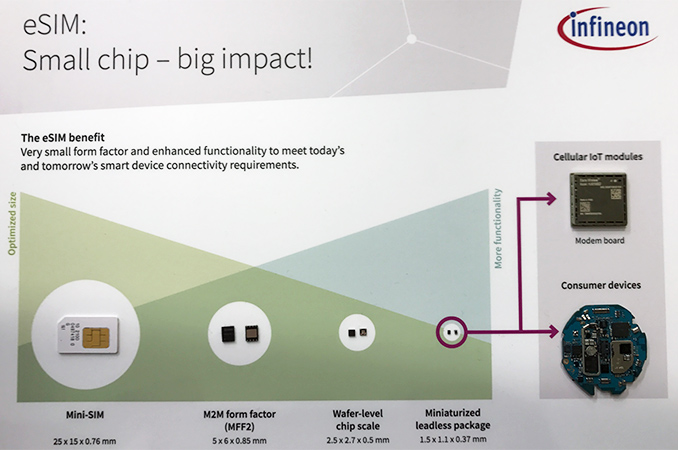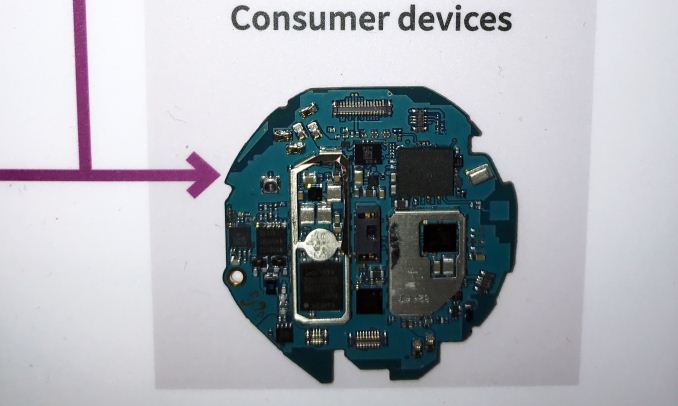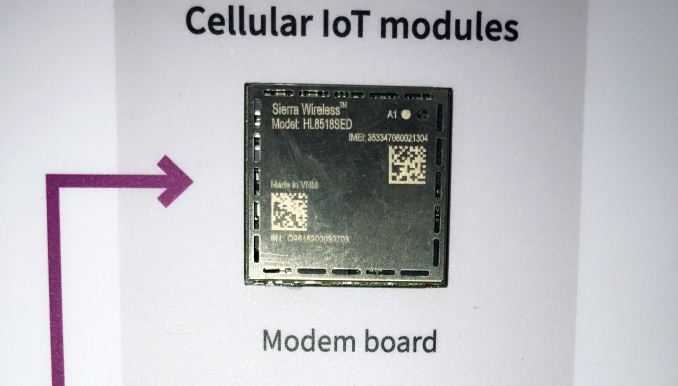Infineon Shows Off Future of eSIM Cards: <1.65 mm2 Made Using 40 nm
by Anton Shilov on March 11, 2017 5:00 PM EST- Posted in
- MWC_2017
- Mobile
- Trade Shows
- Smartwatch
- eSIM
- Infineon
- M2M
- SIM

Update 3/20: Infineon has contacted us and said that the eSIM IC is made using a 40 nm process technology.
At MWC this year, Infineon showcased a lineup of its current and embedded SIM products. The company demonstrates not only the industry-standard MFF2 eSIM chip, but also considerably smaller ICs designed for future miniature devices (many of which may not even exist yet as a category) as well as M2M (machine to machine) applications. It is noteworthy that to manufacture an eSIM the size of a match head, Infineon uses GlobalFoundries 14LPP a 40 nm process technology, taking advantage of leading-edge lithography to bring the size of a simple device down.
The first SIM cards were introduced in 1991 along with the world’s first GSM network operated by Radiolinja in Finland (now the company is called Elisa). Back then, mobile phones were so bulky that a card the size of a credit card (1FF) could fit in. Eventually, handsets got smaller, Mini-SIMs (2FF) replaced full-sized SIMs and then Micro-SIM (3FF) and Nano-SIM (4FF) cards took over. While mobile phones have evolved considerably in terms of feature-set in the last 25 years, the function of the SIM card remained the same: it stores an integrated circuit card identifier (ICCID), an international mobile subscriber identity (IMSI), a location area identity, an authentication key (Ki, this part actually requires a basic 16- or 32-bit compute unit) as well as a phone book and some SMS messages.
By today’s standards, the amount of data that each SIM card stores is so tiny that its physical dimensions are simply not justified. Even Nano-SIMs are too large for applications like a smartwatch, and this is when embedded SIMs come into play: their form-factor is considerably smaller, they can be used with various operators (which makes them more flexible in general) and some of such cards have an expanded feature set (e.g., hardware crypto-processors). Today, there is one internationally recognized form-factor for eSIMs, the MFF2, which is used inside devices like Samsung’s Gear series smartwatch with GSM/3G connectivity. If we actually take a look inside the Gear S2 smartwatch, we will notice that the eSIM is actually one of the largest components and its functionality is disproportional to its dimensions.
At MWC 2017 Infineon is demonstrating two more eSIM implementations, which have not been standardized (yet?), but which are already used inside millions of devices.
The first one, when packaged, has dimensions of 2.5×2.7×0.5 mm, which essentially means that it has no packaging at all. This IC is produced using a mature 65 nm process technology and that means that it is very cheap.
The second eSIM implementation that Infineon demonstrates is actually even tinier: its dimensions when fully packaged and ready to use are just 1.5×1.1×0.37 mm. The IC is made using a 40 nm process technology. Using an advanced process technology to make eSIM cards is not something common, but the approach enables developers of various devices to take advantage of the smallest cards possible (another advantage of such cards are low voltages and power consumption).
It remains to be seen when the industry formally adopts eSIM standards smaller than the MFF2, but dimensions of the eSIMs that Infineon is demonstrating clearly indicate that there are ways to make these cards smaller. Moreover, companies are not afraid of using proprietary/non-standard form-factors are already using the offerings from Infineon. It is up for debate whether using leading-edge process technology for making eSIMs makes sense in general (after all, far not all devices require tiny dimensions and expanded functionality of eSIMs, such as crypto-processors), but with 10 million non-standard eSIMs shipped to date it is obvious that there are mass market devices that can absorb such chips even at potentially premium pricing.
Source: Infineon













28 Comments
View All Comments
ddriver - Saturday, March 11, 2017 - link
Given the tiny amount of data a SIM is supposed to hold, it doesn't seem like process was ever a factor in determining its size. The cards are made big because they are supposed to be manually inserted by average folk.SIM stands for "subscriber identity module". If it is soldered on board and non replaceable, then it isn't really a module, therefore it is not a SIM. It is just a minuscule amount of embedded memory.
solipsism - Saturday, March 11, 2017 - link
It can still be a SIM. In fact, this is far better for users that need to switch SIMs between countries quickly because all it means is they can choose the new SIM from the OS, reboot, and then it'll be connected to that network. You could hold countless SIMs and switch between them without worrying about losing them and the data you've prepaid for. If you, say, only travel for work once a year this can be a nice benefit. If you transfer devices you can copy down the SIM data or maybe the SW will offer up something simple like a QR Code or cloud backup often to save your SIM credentials. This is a good thing.ddriver - Saturday, March 11, 2017 - link
"You could hold countless SIMs"Don't know about that, I can count pretty high.
Embedding has some advantages, modularity has other advantages. I was merely pointing out that if it is not modular, then it is not a "subscriber identity module", at least not from consumer perspective.
Considering it is just a few bytes of data it can easily be a programmable number, without relying on neiter modular nor embedded read-only-memory. If misuse is an issue, then the programming of that memory should be secured, also there is always the security and authentication on the provider side.
LauRoman - Saturday, March 11, 2017 - link
It will end up being another way to lock down the device. Which is not to say that mobile isps don't already lock your device 10 ways to sunday.Anyway how is this practically (not technically) different from (old?) american cdma phones? Yes. i understand they aren't the same, but isn't the end result similar?
Aren't there SIM vulnerabilities already? Are there not going to be more? It's a great idea to have an essential part of a network be embeded. And we don't know how easily patchable it's gonna be.
close - Sunday, March 12, 2017 - link
The difference is that instead of going to the shop and getting a new SIM, you make a phone call and the operator reprograms your eSIM. The disadvantages and pitfalls of this latter option will be seen in practice soon enough.One major disadvantage is for people who are used to swapping SIMs between phones for whatever reason (like running out of battery and wanting to put the SIM in a backup phone or a friend's phone). This of course depends on the actual manner in which this is implemented.
If the response time is minutes then it wouldn't be much of a problem. Otherwise spending hours or days waiting for the operator to reprogram your SIM while you're on vacation might be a major disadvantage that can only be addressed by including "countess" eSIMs in your device. This way you can program one in advance of you travel.
Samus - Sunday, March 12, 2017 - link
eSIM can't have the bulk of its characteristics modified. Some carriers lock a phone number to an ICCID internally to their network, so once activated with a number, the number can not be changed for that SIM. eSIM doesn't circumvent this. Other carriers simply treat eSIM like they would a CDMA device.What we need are vSIM that allow various registers to be rewritten (by the carrier, obviously) to add flexibility.
name99 - Sunday, March 12, 2017 - link
Come on. Le's be honest here. This evolution is utterly idiotic."eSIM" should be a PROTOCOL, a set of mechanisms whereby
- a phone can securely communicate its ID to the network
- a user can securely communicate a newly purchased ID to the phone
- a user can securely transfer the ID from one device to another
To be obsessing about the physical material the data is held in (especially when that prevents transfer from one network to another) is backward beyond belief.
And you're assuming something (that data can be changed on this eSIM) that is not in evidence. Essentially you're assuming the system works the way it SHOULD rather than what's actually being described. What I see described is a very small version of a standard SIM, and I can't change the data as I wish on a standard SIM...
Bullwinkle J Moose - Saturday, March 11, 2017 - link
These are probably embedded Govt SIM chips for the new qualcom servers for WindowsYou won't even know they are on your server and are not intended for end users
They are to Log in silently over the cell network and connect to the hidden encrypted virtual file system to find hidden servers by pinging the embedded GPS and to run malware directly from the hidden file system
Please do not try to shield your server from GPS or Cell signals or it will become non-functional
You may connect to the Internet as you normally would without ever being aware of these new backdoors
LOL
Just kidding......
or am I?
kfishy - Sunday, March 12, 2017 - link
What the hell did I just read.close - Sunday, March 12, 2017 - link
A troll who's trying too hard and falling short...